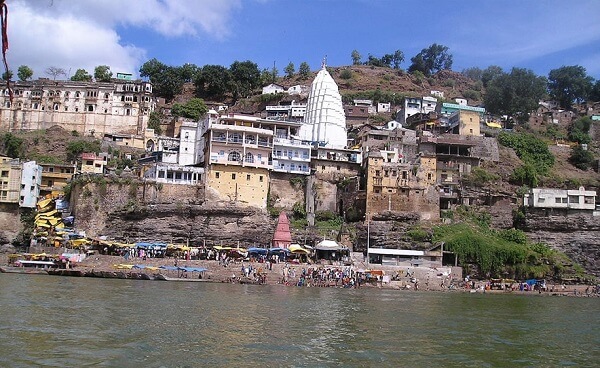
12 Jyotirlinga Tour Packages: Omkareshwar Jyotirling Temple
Omkareshwar or better known as Mandhata Omkareshwar is one of the foremost of the 12 Joytirlingas or it is luminous physical self-presentation of Lord Shiva of the Hindus. Omkareshwar, the sacred island, shaped like the holiest of all Hindu symbols, 'Om', has drawn to it hundreds of generations of pilgrims. Here, at the confluence of the rivers Narmada and Kaveri, the devout gather to kneel before the Jyotirlinga (one of the twelve throughout India) at the temple of Shri Omkar Mandhata. And here, as in so many of Madhya Pradesh's sacred shrines, the works of Nature complement those of man to provide a setting awe-inspiring in its magnificence.
The island comprises two lofty hills and is divided by a valley in such a way that it appears in the shape of the sacred Hindu symbol 'Om' from above. Between the precipitous hills of the Vindhya on the North and the Satpura on the South, the Narmada forms a deep silent pool which in former times was full of alligators and fish, so tame as to take grain from the human hand. This pool is 270 ft below the cantilever type bridge constructed in 1979. The bridge has enhanced the scenic beauty of the place, making it look exceedingly picturesque.
Omkareswar kshetra parikrama is a very important thing to do in Omkareswar tour. The parikrama route Starts from Omkareswar temple and completes after surrounding the hill. Adi Shankaracharya did parikrama when he visited Omkareswar jyotirlinga. While doing parikrama, he met his Guru Sri Govindapada and learned Advaita from him. We can see that place at the end of the parikrama. It is nearer to Omkareswar temple.
First of all, we will reach the Triveni sangamam. Here we can take a holy bath. Just after Triveni sangamam there is a temple of Runa Mukteswar. In this temple, people offer Red gram to Lord Siva. After that, the journey is through the forest. It is very pleasant and nice to see in the Winter season. After crossing this forest there is a temple of Bholenath. It is the midpoint of parikrama. The Siva linga in this temple is very big and it is made of Narmada banam. After that, we will reach the Durga Goddess temple. By crossing Durga temple we will enter into a deep forest. In the forest, there are many ancient monuments and temples which are under the control of Indian Archeological department.
During the Parikrama, numerous Sadhus from diverse traditions are encountered. A stroke of luck might reveal deers and peacocks along the route. The Narmada river, embellished with bridges and the Project, offers a breathtaking view. The final destination is Guru Govindapada's cave. Engaging in this Parikrama brings immense joy. Scholars mention that King Mandhatha of the Ishvaku clan worshipped Shiva here. Moreover, Govinda Bhagavatpaada, Shankaracharya's Guru, is believed to have resided in a cave nearby. Explore this enriching experience with the guidance of Tirth Yatra India, dedicated to enhancing your spiritual journey.
Places to visit
SHRI OMKAR MANDHATA
The temple stands on a one mile long, half mile wide island formed by the fork of the Narmada. The soft stone of which it was constructed has lent its pliable surface to a rare degree of detailed work, of which the frieze figures on the upper portion are the most striking. Also intricately carved is the stone roof of the temple. Encircling the shrine are verandahs with columns which are carved in circles, polygons and squares.
Another popular legend says that once upon a time Vidhya Parvat practiced severe penance and worshipped Parthivarchana along with Lord Omkareshwar for nearly six months. As a result Lord Shiva was pleased and blessed him with the desire boon. On the sincere request of all the gods and the sages Lord Shiva made two parts of the lings. One half being Omkareshwara and the other Amaleshwara or Amareshwar.
THE SIDDNATH TEMPLE
A classic example of early medieval Brahminic architecture, this one is well worth a visit. Its most eye-catching feature is a frieze of elephants over 1.5m high carved on a stone slab at its outer perimeter. Elaborate carved figures decorate the upper portion and the roof of the temple. The shrine is encircled by verandahs with columns carved in circles, polygons and squares.
24 AVATARS
A cluster of Hindu and Jain temples, remarkable for their skillful use of varied architectural modes.
SATMATRIKA TEMPLE
6 km from Omkareshwar, a group of 10th century temples.
KAJAL RANI CAVE
9 km from Omkareshwar a particularly picturesque scenic spot, with a panoramic view of broad acres and gently undulating landscape that stretches in unbroken harmony till the horizon.
Do you have any questions?
Feel free to call us. We have an expert team and we are happy to talk to you.
Teen Dham 11 Jyotirlinga Tirth Yatra- 34 Days
Main Attractions: 11 Jyotirlingas, Kishor Dham, Ganga Sagar, Nepal, Kathmandu
Departure: 13 July 2025
Ek Dham Jagannath Puri Gangasagar Tirth Yatra- 16 Days
Main Attractions: Jagannath Puri Dham, Baijnath Dham, Gangasagar, Ayodhya, Allahabad
Departure: 26 March 2025 & 03 September 2025
Ek Dham Dwarka Puri Yatra - 12 Days
Main Attractions: Dwarka Puri Dham, Seven Jyotirlingas, Statue of Unity
Departure: Coming Soon
Braj Chaurasi Kos Yatra - 10 Days
Main Attractions: Mathura, Vrindavan, Nandgaon, Barsana, Govardhan Parikrama, Braj Chaurasi Kos Yatra
Departure:16 March 2025








